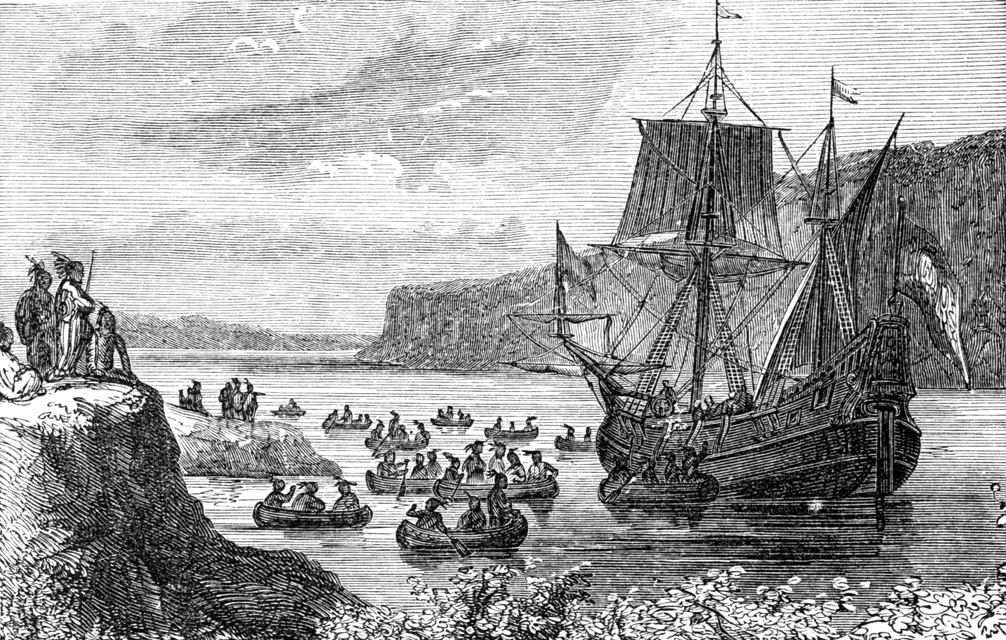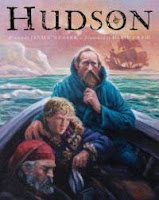Number 2 in the discoveries made at my dad's house from long hidden archives of my work. In my wildest dreams I never thought I'd ever see this picture again, but there it was, in my dad's loft, warts and all, the very first drawing I ever attempted in pen and ink, from 1975, aged 16.
 |
| School project: The Last Voyage of Henry Hudson, copy of an engraving in The Graphic, after the painting by John Collier. Pen & Ink with watercolour on paper. 73cm x 51cm. 1975. |
Prior to this drawing I'd worked steadily but quietly at school on assigned projects. It was acknowledged that I was "good at art", but this was post modernist, late hippy mid 1970's, most of the art classes were light on drawing skills, heavy on texture and tactility, I found little to inspire me. Batik tshirts? Organic bio-plant patterns? Yeuk! No, I wanted to draw! Draw people! Things!
Away from school however I'd long since discovered the joy of the BIC biro, and filled old unused school exercise books with drawings, copied or inspired by WW2
Commando comics. After my dad bought me a couple of Adrian Hill guides to drawing and sketching I'd taken a sketchbook with me everywhere I went, and on every holiday over the previous year filled it with directly observed sketches from life in biro. This was all entirely independant from school. Finally a confrontation with a school bully ended up with the contents of my school bag scattered across the classroom floor, and my sketchbooks were discovered by my form tutor (and art teacher) Al Sayers.
Everything changed from then on. My wonderful art teacher Jackie Asbury (where is she now?) introduced me to a dip pen and a bottle of indian ink for the first time, and told me to draw something challenging. A 19th engraving of Collier's
The Last Voyage of Henry Hudson seemed to fit the bill. I knew absolutely nothing about Henry Hudson or John Collier, or for that matter pen and ink drawing, but I set to and produced this clumsy, tentative piece, little knowing that pen and ink was to become my chief medium for the next 40 years.
Well, this is what I wanted it to look like....
 |
| The source engraving, The Last Voyage of Henry Hudson, after the painting by John Collier |
It's embarassing - those terribly badly drawn hands... it bears little resemblance to the source image, how could I hope to reproduce an engraving with a dip-pen? I had a lot to learn, but it was a start, and I never looked back.
By Roger M. McCoy
Henry Hudson envisioned that he would be the first explorer to find the elusive western passage through North America to the Orient. He persisted in this westward looking vision although his financier, the Dutch East India Company, insisted that he search eastward through the ice-bound sea north of Russia. Hudson had previously tried this northeastern route as well as a northerly route directly over the North Pole. Both had failed due to impassable ice.
On 25 March 1609, Hudson, an Englishman under contract with the Dutch, set sail in the Halve Maen (Half Moon). The Dutch specified that he should not attempt a west route even if the eastern route proved impossible, but Hudson had no interest in another failure. Therefore it is not surprising that he soon found a good reason to end this effort, using the weather as the excuse. As he sailed along the west coast of Norway, the ship encountered severe storms with gale force winds, but examination of the logs also shows much fair weather, raising some doubt that weather actually forced him back. Rather than return to Amsterdam as instructed, Hudson turned west and later anchored in a bay on the coast of Nova Scotia.
On the third of September Hudson sighted an opening to a bay, which appeared to be the mouth of a large river. The next morning they entered what came to be known as New York Bay and dropped anchor. Soon “people of the country” came to the ship carrying trade goods and seemed glad to see the Europeans. They traded green tobacco, deer skins, and maize for knives and beads. He reported that the native people wore skins of foxes and other animals, and were “very civil.” Hudson also noted that the people had copper tobacco pipes, and he inferred that copper naturally existed in the area. Over the next two days other trading sessions took place. Hudson recorded the Indian name for a large island in the river as Manna-Hata.
On the sixth of September five crewmen were determining water depths by boat when they were attacked by natives in two canoes, and one of the crewmen, John Colman, was killed by an arrow in the neck. When Indians came again with their trade goods, the ship’s crew captured two of them briefly, but set one free while the other jumped overboard. No more trading took place under these tense conditions.
Hudson weighed anchor on 13 September 1609 and began his exploration up the great river that still bears his name. He hoped this river might be a connection to the Orient. As the Halve Maen sailed up the river, Hudson wrote in his log, “It is as pleasant a land as one need tread upon; very abundant in all kinds of timber suitable for ship building and for making large casks or vats.” Sixty miles up the river they reported seeing many salmon. “Our boat went out and caught a great many very good fish.” Indians came to the ship and traded corn, pumpkins, and tobacco for what Hudson considered mere trifles, not knowing that the Indians saw these “trifles” as valuable for commerce among themselves.
On the twenty-second of September they found the river too shallow to continue farther upstream, and in the vicinity of present day Albany they turned the ship for a return to the sea. The ship’s log ends during the return crossing with a puzzling gap from the fifth of October to the seventh of November, when the Halve Maen docked in Dartmouth, England. There Hudson was detained by the Crown to prevent him from sailing again for the Dutch. After months of delay the Dutch portion of the crew continued to Amsterdam.
Henry Hudson failed in his quest for a passage through North America, as did many others. This third voyage, however, succeeded by claiming much of present day New York and parts of surrounding states for the Dutch, who began to settle the areas around New York Bay. The Dutch managed to hold their claim until 1674 when the land was ceded to the British.
Why did Hudson stop in England rather than Holland? There is no clear answer; perhaps he was avoiding repercussions for blatantly disregarding instructions, or perhaps the English component of the crew forced him to stop in England. The gap in the log might have shed light on this question. There are several known instances of dissent and mutiny among Hudson’s crews over his four voyages, the last one leading to his abandonment and disappearance with eight others on the shore of Hudson Bay in June 1611. Hudson’s greatest weakness was a leadership style that provoked his crews to mutiny, and in the end this weakness defeated his ambition for exploration.
Roger M. McCoy is Professor Emeritus of Geography at the University of Utah. His books include On the Edge: Mapping North America’s Coast and Ending in Ice: The Revolutionary Idea and Tragic Expedition of Alfred Wegener.
Subscribe to the OUPblog via email or RSS.
Subscribe to only American history articles on the OUPblog via email or RSS.
The post What about Henry Hudson? appeared first on OUPblog.

Weaver, Janice. 2010.
Hudson. Illustrated by David Craig. Ontario, Canada: Tundra.
(Early Reviewer Copy from LibraryThing)The Hudson River, the Hudson Bay, the Hudson Strait - all bear the name of Henry Hudson, the English explorer. Though he never found the northern passage to China that he was seeking, Janice Weaver’s new book,
Hudson, shows that he was likely a competent and fearless seafarer, and ultimately helped to advance humankind’s knowledge of the world.
Working with the very minimal details available about Henry Hudson’s life, Weaver creates a compelling, understandable portrait of Hudson’s complex life, using period quotes whenever possible,
"I hoped to have a clear sea between the land and the ice,” wrote Hudson in his journal, “and be able to circle north of this land.”
The book is divided into short, chronological, illustrated chapters that recount his early life, his four major voyages (1607-1610), the mutiny that likely claimed his life, and its aftermath. Text insets offer additional information to add interest and context to the story. “The Art of Navigation” inset contains a photograph of a seventeenth-century astrolabe and a short explanation of its use and of the many difficulties of sailing in an age when sailors had to rely on the stars to determine their location. Other insets highlight the whaling and spice trades. Particularly interesting is “Of Mariners and Mermaids,” in which readers are reminded of the superstitions of the time.
In Hudson’s journal entry for June 15, 1608, he records matter-of-factly that his men have spotted a mermaid swimming alongside the ship. “She was close to the ship’s side,” he reports, “and looked earnestly at the men.... As they saw her, from the navel upward, her back and breast were like a woman’s... and she had long black hair hanging down behind. In her going down they saw her tail, which was like the tail of a porpoise, and speckled like a mackerel.”
David Craig (
Amelia Earhart: Legend of the Lost Aviator) contributes original paintings depicting life as a seventeenth century mariner. Full-page illustrations of sailors chopping ice, facing stormy seas, and braving icy decks highlight the extremely dangerous nature of early seagoing exploration, particularly when traveling North of the Arctic Circle in a small wooden boat. In addition to the original artwork, images of period maps, paintings and other realia add more interest to an already fascinating story.
Further reading sites, historic sites, credits and an index follow this fascinating look at a fascinating explorer. Interesting and well researched. Recommended for ages 9 and up.
Note: Don’t seal down the dust cover on this one. The inside of the jacket is an attractive poster with map!It’s
Nonfiction Monday! Today’s host is
thebooknosher. Stop by!
Share







Thank you for this review; I look forward to sharing this information with RIF coordinators who are always looking for biographies on individuals not frequently seen on the book shelves!
Wow! I had no idea that Hudson had claimed to see a mermaid. That is so cool. I'll definitely have to check this one out.